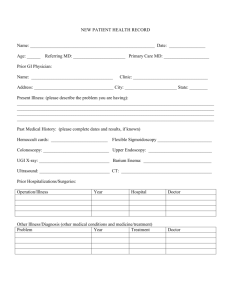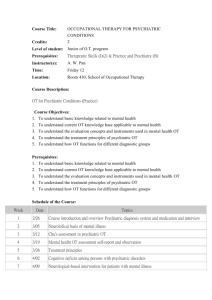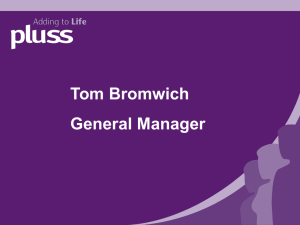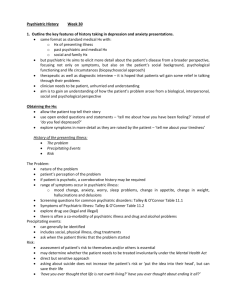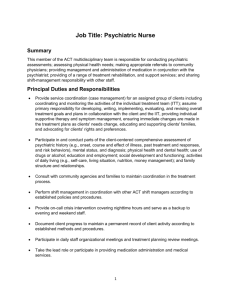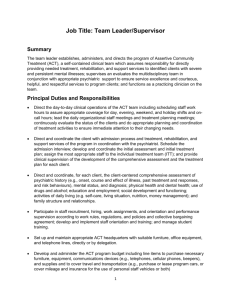081771001.2.3 - Texas A&M Health Science Center
advertisement
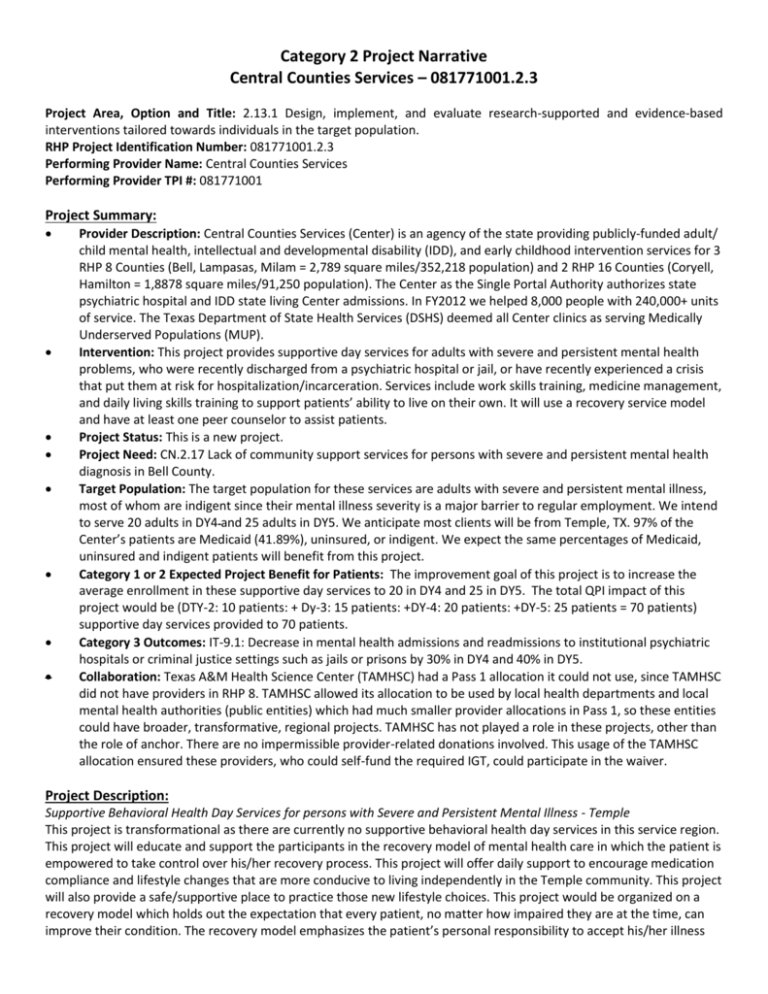
Category 2 Project Narrative Central Counties Services – 081771001.2.3 Project Area, Option and Title: 2.13.1 Design, implement, and evaluate research-supported and evidence-based interventions tailored towards individuals in the target population. RHP Project Identification Number: 081771001.2.3 Performing Provider Name: Central Counties Services Performing Provider TPI #: 081771001 Project Summary: Provider Description: Central Counties Services (Center) is an agency of the state providing publicly-funded adult/ child mental health, intellectual and developmental disability (IDD), and early childhood intervention services for 3 RHP 8 Counties (Bell, Lampasas, Milam = 2,789 square miles/352,218 population) and 2 RHP 16 Counties (Coryell, Hamilton = 1,8878 square miles/91,250 population). The Center as the Single Portal Authority authorizes state psychiatric hospital and IDD state living Center admissions. In FY2012 we helped 8,000 people with 240,000+ units of service. The Texas Department of State Health Services (DSHS) deemed all Center clinics as serving Medically Underserved Populations (MUP). Intervention: This project provides supportive day services for adults with severe and persistent mental health problems, who were recently discharged from a psychiatric hospital or jail, or have recently experienced a crisis that put them at risk for hospitalization/incarceration. Services include work skills training, medicine management, and daily living skills training to support patients’ ability to live on their own. It will use a recovery service model and have at least one peer counselor to assist patients. Project Status: This is a new project. Project Need: CN.2.17 Lack of community support services for persons with severe and persistent mental health diagnosis in Bell County. Target Population: The target population for these services are adults with severe and persistent mental illness, most of whom are indigent since their mental illness severity is a major barrier to regular employment. We intend to serve 20 adults in DY4 and 25 adults in DY5. We anticipate most clients will be from Temple, TX. 97% of the Center’s patients are Medicaid (41.89%), uninsured, or indigent. We expect the same percentages of Medicaid, uninsured and indigent patients will benefit from this project. Category 1 or 2 Expected Project Benefit for Patients: The improvement goal of this project is to increase the average enrollment in these supportive day services to 20 in DY4 and 25 in DY5. The total QPI impact of this project would be (DTY-2: 10 patients: + Dy-3: 15 patients: +DY-4: 20 patients: +DY-5: 25 patients = 70 patients) supportive day services provided to 70 patients. Category 3 Outcomes: IT-9.1: Decrease in mental health admissions and readmissions to institutional psychiatric hospitals or criminal justice settings such as jails or prisons by 30% in DY4 and 40% in DY5. Collaboration: Texas A&M Health Science Center (TAMHSC) had a Pass 1 allocation it could not use, since TAMHSC did not have providers in RHP 8. TAMHSC allowed its allocation to be used by local health departments and local mental health authorities (public entities) which had much smaller provider allocations in Pass 1, so these entities could have broader, transformative, regional projects. TAMHSC has not played a role in these projects, other than the role of anchor. There are no impermissible provider-related donations involved. This usage of the TAMHSC allocation ensured these providers, who could self-fund the required IGT, could participate in the waiver. Project Description: Supportive Behavioral Health Day Services for persons with Severe and Persistent Mental Illness - Temple This project is transformational as there are currently no supportive behavioral health day services in this service region. This project will educate and support the participants in the recovery model of mental health care in which the patient is empowered to take control over his/her recovery process. This project will offer daily support to encourage medication compliance and lifestyle changes that are more conducive to living independently in the Temple community. This project will also provide a safe/supportive place to practice those new lifestyle choices. This project would be organized on a recovery model which holds out the expectation that every patient, no matter how impaired they are at the time, can improve their condition. The recovery model emphasizes the patient’s personal responsibility to accept his/her illness and take personal responsibility to work to improve their level of personal functioning and their quality of life. This project would be staffed to provide supportive day services for up to 20 adults at a time who have a severe and persistent mental illness and reside in the Temple/Belton, TX area. The project participants would be chosen from patients who have experienced frequent psychiatric hospitalizations or incarcerations, or who are imminently at risk of psychiatric hospitalization or incarceration. Patients involved with these services would receive skills training on how to manage: a) their medications, b) their negative symptoms of their mental illness, c) to improve their ability to manage their own living environment and d) to improve their ability to utilize the public transportation system in the Temple/ Belton, TX area. The program would occasionally provide lunch for those attending and would use the shopping for food and meal preparation process as skill-building activities to better equip the patients to live independently. Many of the skill training sessions and social skill building activities would be done as a group to assist the participants in forming mutually supportive relationships with the other program participants. This project would also provide transportation for the patients to assist them with getting settled in the community, and would also work on the patient's use of the public transportation system (bus-stop is one block from the service site). The services would include computers on which to train the patients on how to use them and the internet as a personal resource in their mental health recovery and stabilization. This computer/internet literacy training will be available to participants of the program with staff also educating participants on computer/literacy recourses available elsewhere, such as the Temple Library. This project would include helping the patients to learn more about community resources that are available to them (parks, city wellness/recreation facilities, etc.). This project would also include the recruitment, training, and employment of peer specialists (Menu Category 2.8). The supportive counseling of the peer specialist would both increase the patient’s buy-in with the program, and patient’s sense of support from someone who has managed their severe and persistent mental illness symptoms sufficiently well to be able to support others in their recovery. Each patient participating in this project would have a detailed personal history written up by the staff regarding the patient’s past use of state psychiatric hospital services, local emergency medicine department usage, and criminal/incarceration events in their life. Center staff would help patients explore these events and what led up to them occurring so that alternate choices/behaviors could be identified for the patient. Center staff would work with each patient to develop a practical recovery plan that would strive to put supports in place to assist the patient’s ability to deal with problems without needing institutional support/intervention. All of the above information would be entered into the patient’s electronic health record system of the Center. A medication support group would be formed as part of the services to encourage each patient to comply with their medications, and the follow-up appointments necessary to maintain their medication access/supply. Center staff would also assist the participants to apply for any disability support, housing support, or vocational training support for which they may be eligible, and will also assist the participants in applying for pharmaceutical assistance programs to offset the costs of their medications. A daily attendance roster would also be maintained. If an enrolled patient is absent from the services on a day that he/she was supposed to attend, staff will contact the patient to determine why he/she is not attending. If the patient cannot be contacted, staff will contact local hospitals and jails to determine if the patient has been admitted. Goals and Relationship to Regional Goals: Project Goals: This service has as its goal to reduce the "revolving-door" of hospitalizations/incarcerations of the chronically and persistently mentally ill persons in the Temple/Belton, TX area. This is to be accomplished by the skills training activities available to the patients in this program. It is expected that the longer a patient participates in this service, the greater the length of time will be before further hospitalization/incarceration caused by a mental health crisis occurs. During this stable time it is the service goal to enroll each patient in whatever benefit programs he/she might be eligible for, to include Section-8 housing, Medicaid, Social Security Disability, etc. Accessing these support services will assist the patient in re-structuring his/her community living supports and add to the options for the patient to use to effectively avoid hospitalization or incarceration in the future. This Project meets the following Regional Goals: Improving access to timely, high quality care for residents, including those with multiple needs; Increasing coordination of prevention and care for residents, including those with behavioral or mental health needs; and Reducing inappropriate utilization of services. Challenges: One of the challenges of this project will be finding an appropriate facility in which to offer these services. The facility will need to be close to the local public transportation stops, and convenient to downtown Temple. It will also be a challenge to find a living arrangement for those patients who are coming out of the hospital/jail, or have been living on the street. Ideally the facility used for this service would have shower facilities to facilitate personal hygiene of the patients, a simple kitchen/food storage area in which to teach simple food handling and preparation skills, and sufficient space to have a small computer lab with 6-10 places for patients to practice their computer literacy skills and do simple internet searches. Our Center is exploring a neighborhood just northeast of our downtown Temple area to find a suitable building. This neighborhood is in the vicinity of our Child/Adolescent Behavioral Health Clinic and the Temple main post office. The Center is hesitant to secure a building for this project prior to knowing the approval of this project proposal. 5-Year Expected Outcome for Provider and Patients: It is expected that these services will engage those persons being released from psychiatric hospitalization, those diverted from a psychiatric hospitalization, and those diverted from incarceration into participating in skills trainingbased, supportive day services. The expected outcome would be improved medication compliance, longer periods of staying in the community without hospitalization, arrest, or involvement with emergency department services. Another expected outcome will be in the improvement of the patient’s daily living skills needed for independent living, to include the ability to utilize the local public transportation system, preparing simple one-person menus, shopping for groceries, simple meal preparation, food storage knowledge, and how to put together a simple personal budgeting system. The longer term goals (5+ years) for this project would be to have it evolve into a peer support/drop-in Center that could be used as a support system by person’s who have made major progress in reconstituting their lives – much like the very effective social support system of Alcoholics Anonymous groups. Starting Point/Baseline: This is a new service for the Center so there is no baseline regarding how many days this program will help a person with severe and persistent mental illness stay out of an institutional setting (psychiatric hospital or incarceration). The baseline for each patient will be obtained within two weeks of them becoming involved with these services and will be documented in the patient’s electronic health record. We are optimistic that these services will make a significant difference in the length of time the patients can stay out of an institution. Rationale: Community Need Addressed: Community Need Area: CN.2 - Limited access to mental health/behavioral health services Specific Community Need: CN.2.17 - Lack of community support services for persons with severe and persistent mental health diagnoses in Bell County Persons with severe and persistent mental illness often become more and more isolated from their families and their personal support network. The more their illness progresses, the more withdrawn and isolated they become. We are convinced that bringing a severely and persistently mentally ill person into a supportive environment will make a significant difference in their ability to reverse their isolation and feelings of low self-worth. It is our belief that being able to daily reinforce the tenants of this recovery-model approach to helping patients manage their symptoms and build their personal skills through this day service program will have high impact results in the lives of those served by this program. Core Project Components: a) Assess size, characteristics and needs of target populations (e.g., people with SPMI). This component is addressed in Milestone 1. Central Counties will research different models of day services, interview staff from other programs where this service is offered, conduct an internet search for reference materials/ service models, etc. to be used as the basis for developing our Center’s Implementation plan. b) c) d) e) f) Review literature / experience with populations similar to target population to determine community‐based interventions that are effective in averting negative outcomes such as forensic encounters and in promoting correspondingly positive health and social outcomes / quality of life. This component is also addressed in Milestone 1. This component is also addressed in Milestones 6 and 8 below. Examples of source documents for service design are: “Effectiveness of peer support in reducing readmissions of persons with multiple hospitalizations” W. H. Sledge, et al, Psychiatric Services, 62(5), 541-544; “Planning and creating successful adult day services” Marilyn Martle, LaDonna Jensen, NADSA-AAHSA Whitepaper; “Report of the Mental Health Day Support Work Group, Recovery, Employment, and Rehabilitation Services” Renee Alberts, et al, Falls Church Community Services Board Report, “Peer Support, Whole Health & Resiliency” ; Appalachian Consulting Group, Inc. Cleveland Ga. Develop project evaluation plan using qualitative and quantitative metrics to determine outcomes. The qualitative aspect of this component is also addressed in Milestones 6 and 8 below which are the continuous quality improvement components of this project that strive to continuously improve the quality and effectiveness of the services delivered to each patient under this project. Based on the reports, determine what factors can improve appointment attendance and participation by patients, what procedural activities can be re-organized or streamline to improve the efficiency of documenting services. Revise the items to be tracked and reported upon for future improvement. The quantitative aspects of this component are addressed under Milestones 3 and 5 in which we which seek to increase the number of patients served by this project. Design models which include an appropriate range of community‐based services and residential supports. This component will be addressed in Milestone 1 and will be part of the continuous improvement efforts of Milestones 6 & 8. Also see the Project Description paragraph above which describes the service components to be offered under this project. Assess the impact of interventions based on standardized quantitative measures and qualitative analysis relevant to the target population. This component will be addressed in our Category 3 Milestone which evaluates the reduction of admissions and readmissions into psychiatric hospitals and into criminal justice settings by the severe and persistently mentally ill group of patients served by this project. This component will also be addressed every time the patients’ personal treatment plan is updated through a re-assessment of the patient’s functioning level and recorded in the patient’s electronic health record. Continuous Quality Improvement: The Center is committed to continuous quality improvement and learning related to this project. We will establish quality improvement activities such as rapid cycle improvement and will perform other activities such as “lessons learned” and identifying project impacts. In addition, we are participating in a regional learning collaborative which share information such as challenges, lessons learned and considerations for safety net populations. How the project represents a new initiative or significantly enhances an existing delivery system reform initiative: This project does not supplant any services or funds currently provided to Central Counties Service from the U.S. Department of Health and Human Services. The services proposed to be provided under this project serve to enhance, but not duplicate, the services provided by our Center to persons with severe and persistent behavioral health problems. Related Category 3 Outcome Measure(s): OD-9 Right Care, Right Setting o IT-9.1 Decrease in mental health admissions and readmissions to institutional psychiatric hospitals or criminal justice settings such as jails or prisons The goal of this project is to reduce the number of days people with severe and persistent mental illness spend in state psychiatric hospital services, or incarcerated in local jails due to minor crimes committed in the midst of a mental health crisis. The outcome we will be measuring is the number of days a person with severe and persistent mental illness is able to be in the community rather than in one of these more restrictive and costly institutional settings. We will use the number of days each person was able to stay in the community between their last two admissions, or mental health crisis episodes in which they were at risk of institutionalization as the baseline measure. We will then periodically measure how many days a patient has been able to stay out of an institutional setting with the support of the services offered in this project, and compare that number of days with their personally established baseline. We expect that the longer a patient actively participates in these supportive day services, the more likely that the length of time between institutional episodes will likewise increase significantly. Relationship to Other Projects: This project would provide supportive day services for up to 20 adults with severe and persistent mental illness residing in the Temple/Belton, TX area, and who have experienced frequent psychiatric hospitalizations, or who are imminently at risk of psychiatric re-hospitalization. This project relates to our proposed Crisis Respite Project (#081771001.1.4), as both are aimed at decreasing the use of the state psychiatric hospital system and the criminal justice system in Texas. This project could eventually provide “step-down” services to patients who are just getting out of our proposed crisis respite services The Center has the following projects: 081771001.1.1 Establish more primary care clinics 081771001.1.2 Implement technology-assisted behavioral health services by psychologists, psychiatrists, and other qualified providers 081771001.1.3 Expand the number of community based setting where behavioral health services may be delivered in underserved areas 081771001.1.5 Enhance improvement capacity through technology 081771001.2.1 Apply evidenced-based care management model to patients identified as having high-risk care needs 081771001.2.2 Implement innovative, evidence-based strategies to increase appropriate use of technology and testing for targeted populations Relationship to Other Performing Provider’s Projects and Plan for Learning Collaborative: Bluebonnet Trails Community Center is proposing several services that are similar to this supportive day service, and which are aimed at reducing the cyclical use of the state psychiatric hospital system and local jails. Heart of Texas Regional Center has crisis residential services in place already, as well as a supportive day services site in a large, historic home in Waco, in RHP 16. The Center is committed to improvement of services and broad-level delivery system transformation. We are willing to participate in learning collaboratives with providers in RHP 8 to share successes, challenges, and lessons learned in order to better serve our target population and meet our community needs. Sharing this information at least on a yearly basis will allow providers to strengthen their partnerships and to continue providing services efficiently so there is maximum positive impact on the healthcare delivery system in RHP 8. Project Valuation: The valuation of the project for DY2 includes the purchase of a mini-van, office and program furniture, equipment for a computer lab, audio-video presentation equipment, cooking utensils and equipment, food processing and storage equipment, the hiring and training of staff, supervision of staff, the cost of patient training materials and consumable supplies. The valuation also includes community orientation and recreation activities that promote personal physical wellness. The valuation includes mental health indirect services costs, and administrative costs for this project. Valuation of DYs 3-5 will include increases in staff salaries, and other inflationary cost adjustments. Valuation of this project also takes into account the psychiatric hospitalization and incarceration costs that can be avoided by good, supportive, skill building day services and improved medication compliance. If this project can keep half of its patients (10-15) out of psychiatric hospitals (15 days/admission) or jails (30 days per incarceration event) , it will save our state and communities close to the entire value of this project, not to mention the personal and social costs/tolls these experiences take on the patient’s sense of well-being and physical health.

